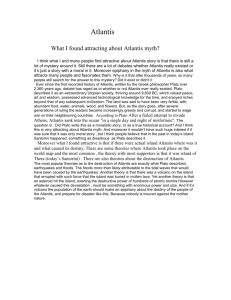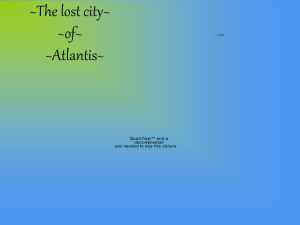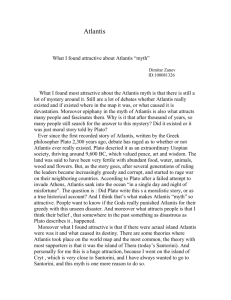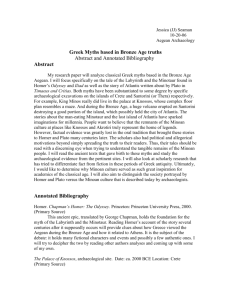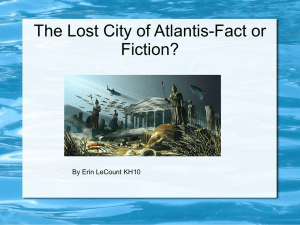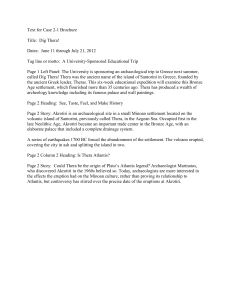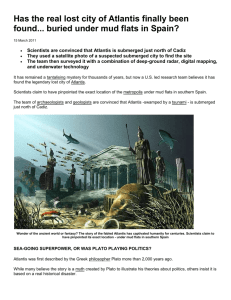Santorini=Atlantis
advertisement
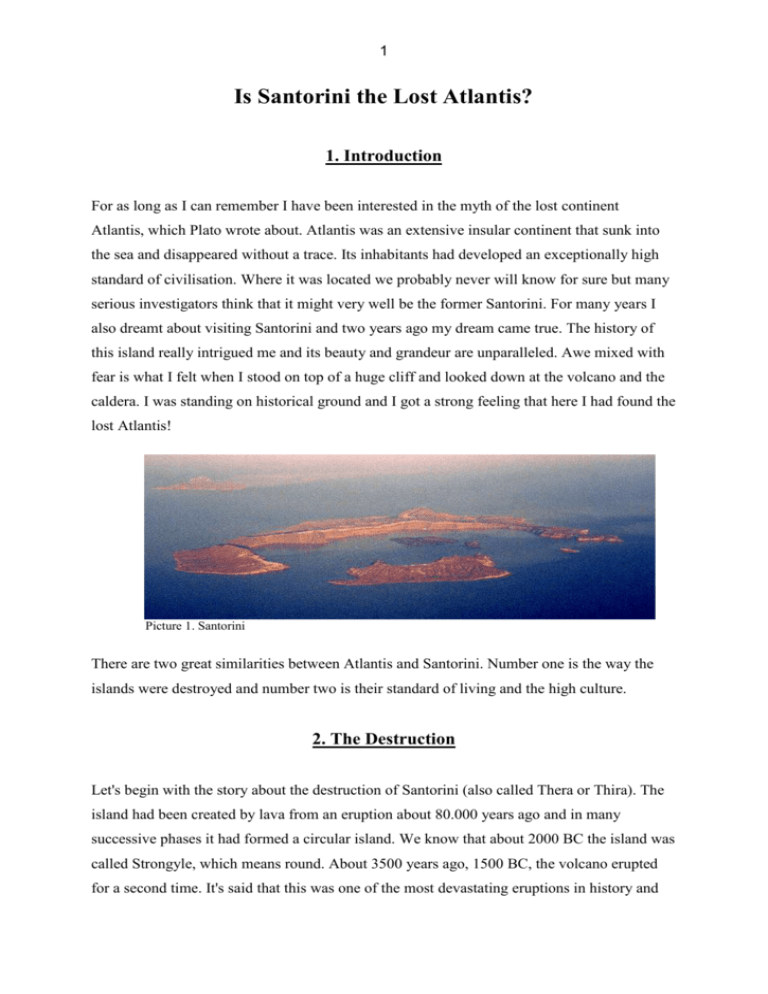
1 Is Santorini the Lost Atlantis? 1. Introduction For as long as I can remember I have been interested in the myth of the lost continent Atlantis, which Plato wrote about. Atlantis was an extensive insular continent that sunk into the sea and disappeared without a trace. Its inhabitants had developed an exceptionally high standard of civilisation. Where it was located we probably never will know for sure but many serious investigators think that it might very well be the former Santorini. For many years I also dreamt about visiting Santorini and two years ago my dream came true. The history of this island really intrigued me and its beauty and grandeur are unparalleled. Awe mixed with fear is what I felt when I stood on top of a huge cliff and looked down at the volcano and the caldera. I was standing on historical ground and I got a strong feeling that here I had found the lost Atlantis! Picture 1. Santorini There are two great similarities between Atlantis and Santorini. Number one is the way the islands were destroyed and number two is their standard of living and the high culture. 2. The Destruction Let's begin with the story about the destruction of Santorini (also called Thera or Thira). The island had been created by lava from an eruption about 80.000 years ago and in many successive phases it had formed a circular island. We know that about 2000 BC the island was called Strongyle, which means round. About 3500 years ago, 1500 BC, the volcano erupted for a second time. It's said that this was one of the most devastating eruptions in history and 2 the crash must have been heard in the whole Mediterranean area. The outpouring lava created an enormous hollow dome directly beneath the centre of the island. When the roof of this dome collapsed, the greater part of Strongyle sank to the bottom of the sea and all that was left above surface of the sea were segments of its perimeter. A tidal wave 250 metre high rushed outward at a speed of 350 kilometres per hour and in less than half an hour it had reached Crete. It probably flooded this island. It's obvious that this catastrophe must have had a great impact on the environment. Ash from this eruption found on the seabed covers an area stretching from Italy, North Africa and as far as Cyprus. Before this ash settled it must have darkened the sky over this area for a very long time. A thick layer of volcanic ash also covered the ground in the Mediterranean countries. It's very likely that the results of the eruption caused failure of the crops, change of climate and other serious consequences in the whole area for many years. The ancient Greek myths and the Old Testament mention terrible disturbances of nature in the Mediterranean. And it's quite conceivable that for example the plagues of Egypt were a result of the collapse of Santorini/Atlantis. Picture 2. Destruction of Atlantis Most likely this natural disaster must have been noticed in the tales passed over to generations in Egypt. The story about Atlantis is in fact a retelling from a legend told by Egyptian priests. This is what Plato wrote about the destruction of Atlantis: “there occurred violent earthquakes and floods, and in a singe day and night of misfortune the island of Atlantis disappeared in the depths of the sea. For which reason the sea in those parts is impassable and impenetrable because there is a shoal of mud in the way and this was caused by the subsidence of the island”. (Santorini Eruptions, www.geology.sdsu.edu). This sounds very much like the eruption on Santorini, doesn't it? 3 3. Standard of Living Regarding the standard of living on Santorini, the excavations of Akrotiri point to an advanced Bronze Age Minoan influenced culture. The art and the wall paintings were very similar to Cretan art in the Minoan period. The island had a flourishing economy provided by intensive trade, shipping, and probably wine. It was an organized community with multistoreyed houses, which had small windows for air circulation, elaborated drainage system, flush toilets and bathtubs. Akrotiri was a valuable port city. Atlantis on the other hand was populated by a noble race and the people were wealthy and powerful. Plato says: “in this island of Atlantis there was a great and wonderful empire, which had rule over the whole island and several others and over parts of the continent” (Santorini Eruptions, www.geology.sdsu.edu). The island was a centre for trade and commerce. Plato tells about Poseidon, the god of Atlantis, that “he found no difficulty in bringing up two springs of water from beneath the earth, one of warm water and the other of cold” (The End of Atlantis, p.164). This could very well be a description of the Minoans and their standard of living. 4. Objections Against the Theory There are of course also some arguments against Santorini as the location of Atlantis. Plato says that Atlantis is a continent and “it's larger than Libya and Asia together” (The End of Atlantis, p.20). The former Santorini was not what we call a continent and not that big. But J.V. Luce says in his book “The End of Atlantis” that Plato probably had a very vague conception of the size of Libya and Asia. Critics also object and say that Atlantis must have been in the Atlantic Ocean because of its name but the name Atlantis actually derives from the mythical Atlas, the giant who held the sky on his shoulders. The Greek word Atlantis simply means the island of Atlas. An interesting detail is that no skeletons have been found under the ashes in Akrotiri. The inhabitants were probably warned by earthquakes and got time to leave. We don't know what happened to them. Maybe they fled to Crete but there they most certainly did drown anyway 4 by the tidal waves from the eruption. So here the stories differ but undoubtedly the consequences of the destruction of Santorini led to the end of the Minoan civilization. 5. Conclusion Was there really an Atlantis or is it just a fairy tale? Nobody knows for sure. Sceptics say that Plato sank his Atlantis in the depths of the ocean to forestall the critic who might ask for the location of the island. Aristotle said: “The man who dreamed it up made it disappear” (The End of Atlantis, p.136). I think Atlantis maybe stands for the lost paradise and that's why so many people, including me, are fascinated by the legend. But some facts remain: It's proved beyond any doubt that the greater part of the former Santorini fell down to the bottom of the sea due to an enormous volcanic eruption. This is very similar to the story about the destruction of Atlantis. We also know for sure, through the exiting archaeological findings in Akrotiri, that the inhabitants on Santorini had a very high standard of civilisation. About Atlantis it's written that talented people of high culture and wealth populated it. Pictures from Knossos: Picture 3. Excavations showing channels for running water. Picture 4. Terracotta drain running under pavement What really fascinates me after all the research I have done is the fact that the Minoans on Santorini, as well as on Crete, already 3500 years ago had developed such a high standard of living and level of culture. Imagine that during the Bronze Age they lived in two- and threestoreyed houses with flush-toilets and drainage while up here in the northern countries we were far from that advanced then! It appears that Minoans heated their houses and had hot and 5 cold running water. The palace Knossos on Crete was said to be the capital of the Minoan culture. A guide on Crete said jokingly that the drainage system in Knossos was more advanced than the system in the modern Greece! What would the world look like today if the Minoans hadn’t been wiped out? The excavations on Santorini continue and most likely there is a lot more to discover. Maybe the truth about the legend is buried under the ash and will be revealed some day? To me it's obvious that the myth of Atlantis is based on the history of the devastating eruption on Santorini. So - the answer to my question in the title is: If Atlantis did exist I'm convinced that Santorini is the lost Atlantis. Picture 5. Fantasy picture of Atlantis 6 6. Reference list: Book references: Luce, J.V. (1970): The End of Atlantis, , Paladin, Frogmore, St Albans Alexakis, G.I. (1987): Santorini Today and Yesterday, Michalis Toumbis SA, Ilioupoli Internet sources: Akrotiri-Lost Atlantis?; http://www.dragonridge.com/greece/minoan1.htm, (21.10.2004) Santorini and the Legend of Atlantis; http://www.decadevolcano.net/santorini/atlantis.htm, (21.10.2004) Atlantis…..Thira?; http://www.angelfire.com/hi/alhawk/atlanthira.html, (21.10.2004) Santorini Eruption (~1630 BC) and the legend of Atlantis http://www.geology.sdsu.edu/how _volcanoes_work/santorini.html, (21.10.2004) Pictures: Picture 1 and picure on the cover : Santorini Eruption (~1630 BC) and the legend of Atlantis; http://www.geology.sdsu.edu/how_volcanoes _work/santorini.html (12.11.2004) Picture 2: Tenerife in Legends; Atlantis; http://www.donquijote.org/tenerife/images/legend4. (12.11.2004) Picture 3 and 4: Knossos, the "Palace of Minos"; http://harpy.uccs.edu/greek/crete/knossos (12.11.2004) Picture 5: Atlantis; http://www.kunstgeografie.nl/Atlantis1Akopie.jpg, (12.11.2004)
